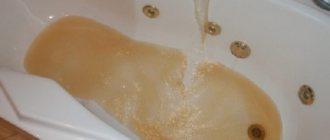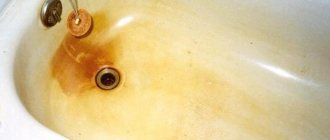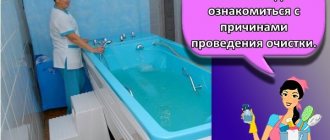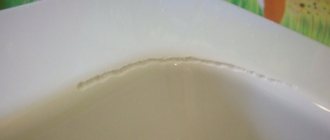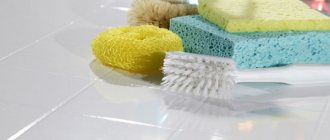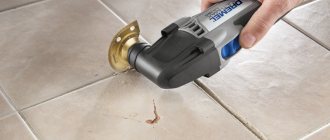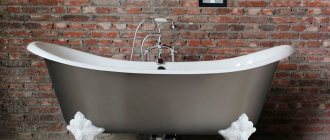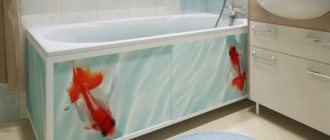A snow-white bathroom is the dream of many housewives. I'll tell you how to achieve it without spending a lot of time and effort. In most cases, the object of increased attention is the bath itself. Any plumbing fixtures can suffer from rust, yellowing, limescale and ingrained dirt if not properly maintained. The material of manufacture is not particularly important.
Preparing for cleaning
There are universal and highly specialized means. They are used for different purposes. For example, substances of the first group will help get rid of any kind of stubborn dirt. Highly specialized ones, on the contrary, remove only some stains. For this reason, you must first determine the type of contamination, which will increase the effectiveness of the detergent. Possible options:
Rust may appear due to a breakdown of common house pumping equipment.
- lime: traces of water drops remain on the mixer and the surface of the bowl, the reason lies in its increased hardness;
- soap scum: this leaves stains of different colors (which depends on the shade of the soap) or a whitish film covering the entire bowl; it forms during the process of taking a shower or bath;
- rust: a consequence of a breakdown of common house pumping equipment or replacement of communications; sometimes low-quality water is supplied to the facility;
- mold - develops in conditions of high humidity and when air circulation is disrupted;
- colored spots are a consequence of careless hair dyeing at home, brilliant green or potassium permanganate is spilled;
- traces of repair (plaster, cement mortar, sealant, polyurethane foam, etc.).
Depending on the nature of the contamination, a cleaning method is selected. In this case, you need to take into account the properties of the bowl’s coating. If you do not follow these recommendations, you can ruin your plumbing. Use acidic materials and powders with caution. The latter are characterized by abrasive properties and will easily damage the coating of the plumbing bowl.
Causes of stains in the bathtub and their nature
To quickly and effectively get rid of a problem, you need to understand the reasons that caused it. The list is quite extensive and includes:
- interaction with water;
- high humidity;
- sudden changes in temperature;
- residues of detergents and cleaning products;
- faulty plumbing equipment.
You must not forget that the bath should be used only for its intended purpose. Regular violation of this rule is fraught with the appearance of blockages and destruction of the protective layer.
Soap scum is the result of using gels, shampoos and other detergent compositions. Contrary to popular belief, it is unlikely that you will be able to completely remove the film by simply rinsing the bathtub. Over time, it eats more and more into the surface of the product, negatively affecting its appearance. In this case, you cannot do without special tools.
Limescale deposits are a sign that the tap water is too hard. Yellow stains are caused by leaks, and rust is caused by high iron content. Mold and mildew can be found between the tiles and the bathtub.
Cleaning methods without using chemicals
Ways to clean a bathtub at home.
To remove traces of various substances from the surface of the bathtub, remove plaque and rust, it is first recommended to use effective home remedies.
They differ from specialty chemicals in that they work gently. The coating will remain intact even after repeated use of substances prepared based on folk recipes.
However, this method also has disadvantages, such as low efficiency. With their help, you can wipe off fresh stains and remove light dirt. Moreover, increasing the dose of active components will not provide the required result.
Lemon acid
This product is moderately aggressive. The acid helps remove traces of rusty water. It will not remove complex stains, but it can significantly lighten the coating. It is necessary to use the acid correctly, which will increase its level of effectiveness. They use methods based on exposure to a concentrated solution and water containing a small amount of the substance. They are used in different cases. Algorithm of actions:
- Prepare a concentrated solution. To do this, stir 1 packet of acetic acid in 1 glass of water (250 ml). All surfaces of the plumbing fixture bowl are treated with the substance, but it is best to clean those areas where the yellow coating is more visible. Then the bath is left in this state for half an hour. During this time, the acid will penetrate the surface layer of the coating and destroy the contaminants. After half an hour, the product must be washed off the walls of the bowl.
- Use of a low concentration solution. Mix citric acid with water, for which use the above recipe. Then fill the bath with water to the hole at the top of the bowl (overflow) or to the level where a yellow coating has formed. It is necessary to pour the solution into water. The substance is left in the bath for 3 hours. If the stains are complex, the dark coating may lighten slightly. When fresh stains need to be removed, the cleaner helps restore the whiteness of the plumbing fixtures. After 3 hours, the solution is washed off with water, after emptying the bath.
Citric acid removes complex stains.
After applying the acid, you can rub the stains with baking soda. This method is chosen taking into account the type of coating of the bowl, since the abrasive is not suitable for all facing materials - it has a damaging effect.
Soda and vinegar
This combination is used only if individual substances do not provide the desired result. Subtleties of using soda:
- Prepare the slurry: mix soda with water. The number of components is arbitrary; it is important to obtain a thick substance at the output, which is characterized by a high viscosity index, which will not allow the substance to spread.
- The gruel is applied to all surfaces of the bowl of the plumbing fixture. If the coating material is insensitive to abrasive, rub the bowl with soda using a soft sponge. In other cases, soda does not need to be rubbed into surfaces so as not to damage the enamel.
- After 1 hour, you can remove the layer of slurry with a stream of water. Alternatively, you need to wait until the mixture dries, after which you can remove the dry powder. In such cases, you should not use hot water to clean the bowl.
A combination of baking soda and vinegar helps remove tough stains.
Clean the bathtub until it is snow-white; soda ash will help remove black deposits. The method of using such a powder is similar to the previously discussed option.
It is necessary to mix soda ash and baking soda, the ratio of components is 1:1. Then add water, but in a minimal amount, until a paste is obtained. It is necessary to wear gloves when working with soda ash. Apply the product to the surface of the bowl and leave for half an hour.
At this time, a vinegar solution is prepared. You need to mix 0.5 cups of essence and the same amount of bleach. The solution is applied to the walls of the bowl directly on top of the soda slurry. Leave the bath in this form for 30-40 minutes.
At the end of this period of time, you need to rub difficult stains on the surface of the bowl with a medium-hard sponge. Then the substance is washed off with water. Soda ash can remove the toughest stains from your bathtub.
Before using such a product, you need to do a test on a small and inconspicuous area, checking how the coating of the bowl will withstand its impact.
Removing rust
First, consider methods with ammonia, salt, and vinegar. These substances will help you easily get rid of light stains. They are used separately. It is enough to rub the stain for several minutes using ammonia or salt and vinegar. Lemon juice is used in the same way. However, the effectiveness of this product is low, so it is recommended to use it to regularly care for the bath bowl, removing light stains.
To remove rust, you need to use vinegar and bleach.
Another effective method against rust is to gradually apply a mixture of soda ash and baking soda, as well as a vinegar + bleach combination. It is distinguished by its universal action and comparative ease of use. Another method is also used:
- The inner walls of the bowl are treated with fine-grained moistened salt.
- A soft sponge must be moistened with turpentine, after which all surfaces of the bath are wiped. You need to work with gloves.
- The product must be washed off with water, and dishwashing liquid is added to enhance the effect.
Removing limescale
Mix baking soda and soda ash in equal parts. The powder needs to be moistened. Then the resulting slurry is applied to the walls of the bowl. After 30 minutes, the substance is removed from surfaces using a stream of water. You need to moisten paper napkins with vinegar and lay them out along the bottom of the bath. If required, the walls of the plumbing fixture are also covered. The substance must act for 5 hours. Then it is washed off.
Mold
Black spots of fungus must be removed. Both traditional methods and household chemicals will help:
- Coal. Grind the tablets and mix with liquid bleach until a porridge-like consistency is obtained. Distribute the resulting product over the stain, leave for 1 hour and rinse.
- Soda and vinegar. To clean, sprinkle baking soda in a thick, even layer over areas with mold, then pour in vinegar and leave until the reaction is complete.
- Mold stains can be washed off with laundry soap, but this must be done regularly.
- Copper sulfate. It is dissolved in water and applied with a brush to areas with mold. This must be done with gloves.
- To clean the bathtub, household chemicals are used. A simple option is bleach or chlorine. Apply the product to the affected areas and leave for 15 minutes, then rinse with water.
Household chemicals for bathtub cleaning
There are a large number of options for such products, so it becomes difficult to choose the most suitable one. Before purchasing, study the information from the manufacturer on the label. This makes it possible to select a substance in accordance with the type of material from which the bathtub and lining are made.
Domestos is perfect for cleaning bathtubs with chemicals.
Instructions for use are often standard: the product is applied to the walls of the bowl and left for a certain period (depending on the brand). Upon completion, the substance is washed off with water. If you leave the product on the walls of the bowl, the lining may be damaged. They use products from different brands:
- Cif;
- Domestos;
- Mr. Muscle et al.
General recommendations
When cleaning a bathtub, you have to deal with typical contaminants: grease residues, soap stains, limescale and rusty streams.
If the product is new and without defects, the main principle of care is not to damage the enamel surface. Most mistakes are made due to ignorance or carelessness. In order not to spoil the coating, manufacturers categorically do not recommend the following for washing enamel bathtubs:
- metal and fiberglass brushes and scrapers;
- abrasive powders;
- aggressive acids;
- concentrated chlorine-containing compounds.
Note: The resistance of enamel to chemical influences depends on its thickness, number of layers and application technology. Domestic and inexpensive Chinese baths are covered with enamel in an outdated way - in drying chambers (hot drying method). The surface of such products is fragile and often uneven. Bathtubs made in Spain, France and Germany are coated with ultraviolet-curing powder enamels, which greatly increases their wear resistance. But such products have a high price and are not always available to the average consumer.
Choosing a product depending on the bathroom material
When it is planned to use an aggressive substance, the properties of the material from which the plumbing fixture is made are studied. For example, a cast iron fixture cannot withstand the effects of acid and abrasives. However, acetic and citric acids can be used, which is due to their much milder effect compared to ready-made products. Ammonia is also used.
Acrylic
To clean such a bowl, you cannot use any acids or alkalis. This may damage the coating. Do not use alcohol- or chlorine-containing solutions. Lime is removed from the surface of the bath using washing powder diluted with water. It is permissible to use heated vinegar and salt. You can use turpentine. It is combined with fine-grained salt.
Turpentine is one of the acceptable cleaning agents for acrylic bathtubs.
Enameled
Do not use abrasive substances to clean this device. Allowed means:
- ammonia;
- hydrogen peroxide;
- vinegar;
- lemon juice;
- baking soda.
An enamel bath can be cleaned with lemon juice.
It is permissible to treat the walls with fine-grained salt; a thick slurry is prepared based on this component. A good result is provided by lemon juice in combination with ammonia. Despite the aggressive effects, it is permissible to use a mixture of soda ash and baking soda. Mustard powder is also used to clean enamel walls.
Safety precautions when working with chemicals for cleaning plumbing fixtures
- Wear rubber gloves, otherwise you may get burns, damage your nails, or damage the epidermis.
- Use a respirator or gauze bandage to prevent toxic fumes and powder dust from entering the lungs.
- The room should be well ventilated.
- After using the product, thoroughly rinse it off the product; residues of the product on the surface are unacceptable. They will damage the coating and have a negative effect on the human body when taking a bath or shower.
In case of contact with skin or eyes, rinse with plenty of warm water.
Removing other types of contaminants
Even if the product is used as intended, various nuances may arise during the work process. In addition, the type of pollution is taken into account. Some substances have a stronger effect on a number of materials and, conversely, are almost ineffective when trying to influence other compounds.
How to clean a bathtub from potassium permanganate and brilliant green
A combination of citric acid and hydrogen peroxide will help remove traces of potassium permanganate.
These substances strongly stain any surface. To remove traces of potassium permanganate, use a combination of citric acid (or fresh lemon juice) and hydrogen peroxide.
The brilliant green solution is cleaned from surfaces using alcohol. However, this option is ineffective in cases where an acrylic bowl is installed.
How to clean a bathtub after renovation
Citric acid helps get rid of the effects of dust. Contaminants are removed with water, then the walls of the bowl are treated. Paint can be removed with solvents, but first you need to do a test to check how such a substance will affect the bathtub coating.
How to remove sealant
First, remove most of the silicone. Residues are removed using salt-based products. Considering that abrasive is used, this option is not suitable for all types of plumbing fixtures. Special products from the chemical industry are more effective.
Methods for removing sealant in the bathroom.
How to clean an old bathtub
The best option is soda ash. This substance penetrates deep into the coating, fills microcracks, due to which the walls of the bowl brighten. You can use a method using baking soda, soda ash and bleach with vinegar.
What can't be used?
When cleaning the bathtub, you should remember that not all products and tools are universal. Some of them can cause damage to enamel, acrylic or metal surfaces.
To avoid damaging your plumbing when removing yellow stains, it is recommended to exclude:
- Steel wool and brushes. Hard products leave scratches, as a result of which the bathtub will require cosmetic repairs.
- Strong acids and alkalis. These reagents can ruin acrylic and enamel and thin the walls of a metal bath.
- Products intended for cleaning toilets. Such gels contain aggressive components that can damage the bathtub coating.
Bathroom care rules
You need to take 2 tips as a basis:
- Every day, wash the walls of the bowl with soapy water; instead, use liquid soap; use a sponge for application;
- at the end of the day, and best of all, after each use, the bath should be wiped dry, this will prevent the formation of limescale and the appearance of yellowness.
If colored stains appear (from hair dye, brilliant green, etc.), they must be removed immediately. If you leave complex contaminants on the surface of the bowl and continue to use it, the substance will penetrate deep into the lining structure. As a result, it will be difficult to remove such a stain.
Soda
You can remove traces of water and rust using soda, and both regular food soda and soda ash cope equally well with the task.
- Soda is applied to the wet surface of the bath.
- A few minutes after application, it can be washed off with warm water, as it begins to act very quickly.
If there are old stains on the surface of the bath, then the exposure time of the soda can be increased to 15-20 minutes, after which it should be washed off with water.
What products will harm plumbing?
For acrylic bathtubs, you need to use only special household chemicals; information can be found on the label. For bathrooms with enamel coating, the use of:
- Brushes with metallic inclusions in the bristles, hard fiberglass sponges.
- Laundry washing powder.
- Methods with hard abrasive particles, special cleaning powders must be treated with great care. Daily use may cause scratches.
- Any products containing alcohol, gasoline, acetone. They will clean white, but may damage the surface.
- If chlorine is present in the composition, the product is not for daily use.
Bathroom remodelers warn that using even special household chemicals not according to instructions can ruin any surface. It is important to maintain time limits and take precautions.
The article has been verified by the editors
